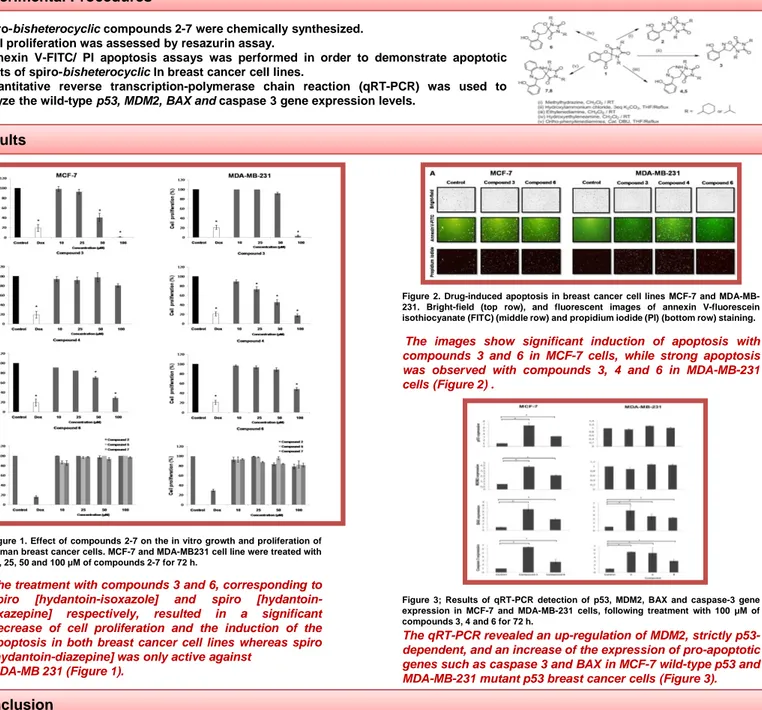HAL Id: hal-01594048
https://hal.archives-ouvertes.fr/hal-01594048
Submitted on 26 Sep 2017
HAL is a multi-disciplinary open access
archive for the deposit and dissemination of
sci-entific research documents, whether they are
pub-lished or not. The documents may come from
teaching and research institutions in France or
abroad, or from public or private research centers.
L’archive ouverte pluridisciplinaire HAL, est
destinée au dépôt et à la diffusion de documents
scientifiques de niveau recherche, publiés ou non,
émanant des établissements d’enseignement et de
recherche français ou étrangers, des laboratoires
publics ou privés.
Distributed under a Creative Commons Attribution - ShareAlike| 4.0 International
License
Effects of Spiro-bisheterocycles on Proliferation and
Apoptosis in Human Breast Cancer Cell Lines
Lamia Hamdan Ramdani, Oualid Tahli, Laetitia Delort, Caroline Decombat,
Arthur Silva, Khaldoun Bachari, Marie-Paule Vasson, Florence
Caldefie-Chezet
To cite this version:
Lamia Hamdan Ramdani, Oualid Tahli, Laetitia Delort, Caroline Decombat, Arthur Silva, et al..
Effects of Spiro-bisheterocycles on Proliferation and Apoptosis in Human Breast Cancer Cell Lines.
Fourth International Congress of Translational Research in Human Nutrition ICTRHN 2017, Jun
2017, Clermont-Ferrand, France. 45 p., 2017, 4th International Congress of Translational Research in
Human Nutrition & Cancer:Abstract Book. �hal-01594048�
Lamia HAMDAN RAMDANI1,2, Oualid TALHI1,4,Nadia TAIBI1, Laetitia DELORT2, Caroline DECOMBAT2, Artur SILVA4,
Khaldoun BACHARI1, Marie-Paule VASSON2,3, and Florence CALDEFIE-CHEZET2
Effects of Spiro-bisheterocycles on Proliferation and Apoptosis in Human Breast
Cancer Cell Lines
Breast cancer is the first cause of cancer death in women worldwide and a major concern to public health. Targeting p53–MDM2 interaction by using appropriate molecules offers an attractive strategy for p53 activation and a promising approach for new anticancer therapies. In this context, we provide an account of the evaluation of small molecules containing oxygen and nitrogen
spiro-bisheterocycles in terms of effects on in vitro proliferation and apoptosis of human breast cancer cell lines (MCF-7 and MDA-MB231). The
wider aim is to identify novel low-molecular-weight, easily-accessible synthetic spiro compounds for cancer chemotherapy.
Results
Figure 1. Effect of compounds 2-7 on the in vitro growth and proliferation of human breast cancer cells. MCF-7 and MDA-MB231 cell line were treated with 10, 25, 50 and 100µM of compounds 2-7 for 72 h.
Figure 2. Drug-induced apoptosis in breast cancer cell lines MCF-7 and MDA-MB-231. Bright-field (top row), and fluorescent images of annexin V-fluorescein isothiocyanate (FITC) (middle row) and propidium iodide (PI) (bottom row) staining.
The images show significant induction of apoptosis with compounds 3 and 6 in MCF-7 cells, while strong apoptosis was observed with compounds 3, 4 and 6 in MDA-MB-231 cells (Figure 2) .
Figure 3; Results of qRT-PCR detection of p53, MDM2, BAX and caspase-3 gene expression in MCF-7 and MDA-MB-231 cells, following treatment with 100µM of compounds 3, 4 and 6 for 72 h.
The qRT-PCR revealed an up-regulation of MDM2, strictly p53-dependent, and an increase of the expression of pro-apoptotic genes such as caspase 3 and BAX in MCF-7 wild-type p53 and MDA-MB-231 mutant p53 breast cancer cells (Figure 3). The treatment with compounds 3 and 6, corresponding to
spiro [hydantoin-isoxazole] and spiro
[hydantoin-oxazepine] respectively, resulted in a significant
decrease of cell proliferation and the induction of the apoptosis in both breast cancer cell lines whereas spiro [hydantoin-diazepine] was only active against
MDA-MB 231 (Figure 1).
Conclusion
In summary, this study brings the first demonstration that new small spiro-bisheterocyclic molecules can sensitize breast cancer cells to apoptosis by targeting p53–MDM2 interaction. We also highlighted that these spiro compounds promote apoptosis via p53- independent pathway(s), suggesting that these compounds represent interesting candidates as therapeutic targets for the treatment of breast cancer.
1CENTRE DERECHERCHESCIENTIFIQUE ETTECHNIQUE ENANALYSESPHYSICO-CHIMIQUES(CRAPC), TIPAZA, ALGÉRIE; 2UNIVERSITÉCLERMONTAUVERGNE, INRA, UNH, UNITÉ DENUTRITIONHUMAINE, CRNH AUVERGNE, F-63000 CLERMONT-FERRAND, FRANCE
3CENTREJEAN-PERRIN, CLERMONT-FERRAND, FRANCE;
4ORGANICCHEMISTRY, NATURALPRODUCTS ANDAGRIFOOD(QOPNA), DEPARTMENT OFCHEMISTRY& QOPNA, UNIVERSITY OFAVEIRO, AVEIRO,
PORTUGAL
Context and Objective
Experimental Procedures
Spiro-bisheterocyclic compounds 2-7 were chemically synthesized. Cell proliferation was assessed by resazurin assay.
Annexin V-FITC/ PI apoptosis assays was performed in order to demonstrate apoptotic effects of spiro-bisheterocyclic In breast cancer cell lines.
Quantitative reverse transcription-polymerase chain reaction (qRT-PCR) was used to analyze the wild-type p53, MDM2, BAX and caspase 3 gene expression levels.
